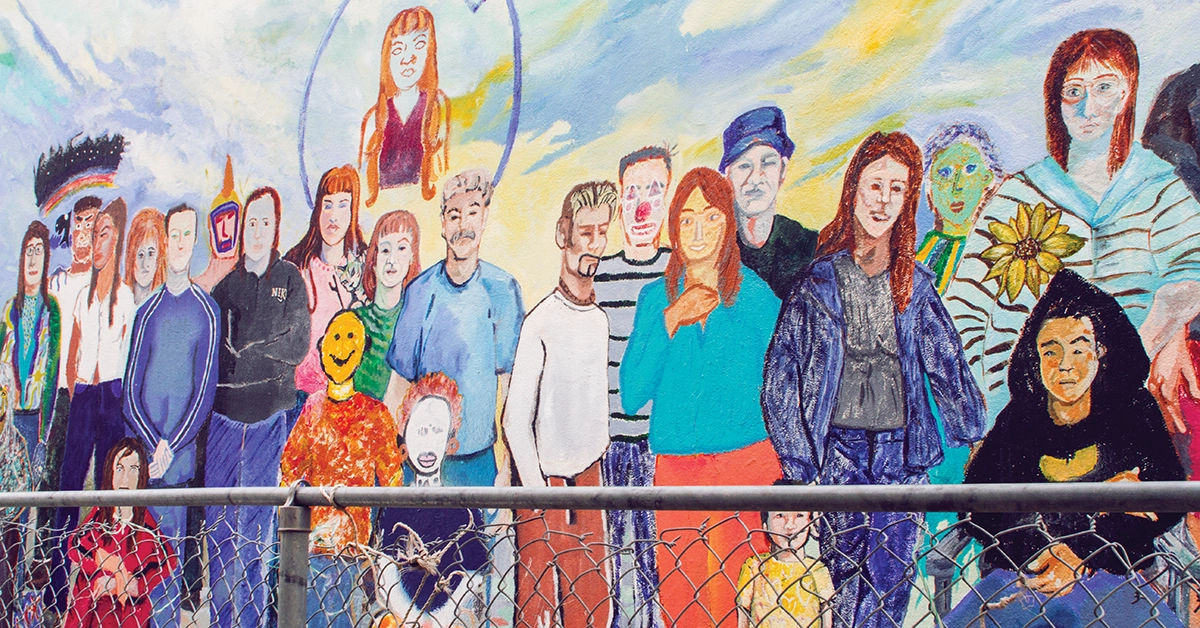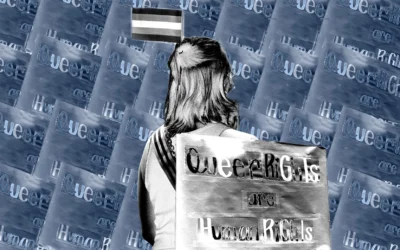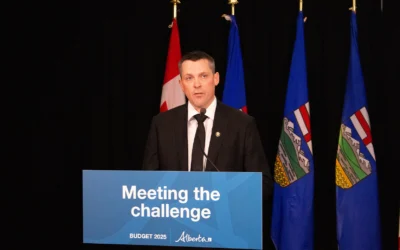Downtown Edmonton is in a state of upheaval. Roads are littered with neon signage pushing cars into single lanes. Pedestrians walk through covered passageways, occasionally peeking through crude holes to see the scaffolding that lies behind the barriers. New buildings are popping up all over the downtown core, from expansions to the MacEwan University and NorQuest campuses to the new Royal Alberta Museum and, of course, the controversial Ice District.
Just beyond the massive, looming skeleton of the Rogers Place arena, a dozen or so people line the sidewalk in front of Boyle Street Community Services. I’ve been a downtown resident for most of my life, and I’ve walked past the Boyle Street building countless times, but I’m ashamed to say that I had never stepped foot inside prior to writing this story. The squat, warehouse-like service centre lies just three blocks east of MacEwan University’s City Centre Campus, and its colourful, muralled façade belies the daily struggles faced by the population inside.
The Boyle Street building looks modest in size as you approach it, but it seems to expand once you open the door. Julian Daly, the executive director of Boyle Street Community Services, pegs the interior at a sprawling 25,000 square feet. “It’s like the TARDIS, if you’re a Doctor Who fan,” he says, chuckling. Daly is one of the only people I’ve ever met who could be described as jolly. Hailing from Ireland, he has lived in Edmonton for nearly a decade and worked at Boyle Street for much of that time. He seems far from discouraged by the rapid development of the region around Boyle Street, though he acknowledges that it could have been a significant problem if the organization hadn’t bought its building two years ago. “When we didn’t own our building, I think we were very vulnerable and I think we would have been displaced from here and made homeless, which would have been ironic as a homeless-serving organization,” says Daly, “and I don’t think people would have been crying out to give us a new home.”
Boyle Street Community Services offers a wide range of services for people experiencing homelessness and poverty. The drop-in centre provides items such as shampoo and feminine hygiene products, referrals for vision and medical care, and recreational activities. Boyle Street clients can receive access to phones and computers, transit tickets, ID and personal document storage, and mail services (the organization allows homeless people to use the building as their mailing address). Boyle Street also offers outreach services, access to addictions counselling, housing assistance, and employment programs.
Rather than be left behind, Boyle Street has embraced the changes to the downtown core and is planning to redevelop its own site as well. “We’re not in the business of ghettoizing here,” says Daly. “I mean, sometimes homeless folk get ghettoized, but we don’t want to be. We want to be a part of this, what’s going on.” The organization has completed the business plan for a new building and is currently in the design process with Manasc Isaac Architects. The proposed building would be 15 stories tall (as per the lot’s zoning) and would have the capacity for more services, as well as affordable housing and market space. Daly explains that the building would, ideally, be a place that other community members would visit, allowing more integration between the people that Boyle Street serves and the rest of the downtown population. “I mean, obviously it’s primarily going to still focus on the needs of the community that we’ve traditionally served, but I think we can create a community centre that is more open to others,” he explains.
Daly describes the proposed building’s architecture as “unapologetically indigenous in design,” noting that almost 80 per cent of Boyle Street’s client base is of indigenous descent. He emphasizes that homelessness and poverty disproportionately affect our indigenous population due to the generational trauma caused by colonialism and residential schools in Canada. “Those folk have been largely invisible in the city,” he adds.
Sadly, when people experiencing homelessness are visible, they are often met with fear and contempt from other citizens. In fact, the sight of homeless citizens sitting in front of the Boyle Street building sometimes unsettles passersby. “We’ll also be using the architecture to design in such a way that those we serve have a safe place off the street. Because I know that the community we serve, as you can see today, are outside on both sides of the street, and that worries some folk and frightens them,” he explains. “Although, in the seven years I’ve been here, there’s never been one incident — and I would know about it — where any of our community members or any of our clients have ever attacked anyone walking, just a random person.”
While stakeholder meetings have taken place throughout Boyle Street’s planning process — and Ward 6 Councillor Scott McKeen and Edmonton-Centre MLA David Shepherd are both aware of the proposed redevelopment — no funding requests will be made until the building design is complete. “We’ve had preliminary discussions with a number of people but there’s nothing concrete as yet,” says Daly.
Councillor Scott McKeen has worked downtown for nearly three decades, so he acknowledges the merit of redeveloping the region, which he describes as having been “moribund for about 30 years.” He speaks enthusiastically about the future of the downtown core, but he readily acknowledges that there is much work left to do for marginalized people in the city centre. According to McKeen, Boyle Street Community Services is just one of three organizations in the region aiming to redevelop their sites. “We need to know if these are the right places, offering the right mix of housing, and [if they] fit well with an overall strategy,” he says. “How do those three proposals, major expansions in the Boyle-McCauley area, work together? Do they duplicate each other, for example? Do they meet the goal of doing what’s best for communities and for these very vulnerable people?”
Daly remains optimistic about Boyle Street’s plans for redevelopment. He notes that our municipal and provincial governments have recently dedicated hefty sums of money to numerous downtown development projects, and that Boyle Street is looking for only a fraction of the funding. Revamping downtown is great, Daly notes, but we should also be willing to put money toward helping our most vulnerable populations. “I think a society can often be judged by how it treats its richest citizens and its poorest citizens,” says Daly. “And frankly, I’d want to be living in a society that treats its poorest citizens well and does not bias the system and the resources in favour of its richest citizens.”
After all, it would be a shame to spend hundreds of millions of dollars on an arena, only to leave abject poverty in its shadow.
A “Service Gap” for Marginalized Citizens
Boyle Street Community Services partnered with Edmonton Public Library (EPL) in 2011 to develop an outreach program for its Stanley A. Milner branch. The program was created in response to the needs of people experiencing homelessness — a population that relies heavily on the downtown library. The space is a safe haven for people who want a warm place to relax but don’t have the economic means to purchase anything in exchange.
Beyond its outreach program, EPL reduces barriers in many ways, including offering a library card that does not require a home address. This card is invaluable because it allows access to all of the library’s in-house services, including computers that people can use to check emails and apply for jobs. EPL’s Community-Led Service Philosophy states: “EPL’s focus is on anyone facing barriers to using library services — from people who are homeless and socially excluded to the middle-class mom who has had a bad customer experience during a program and does not want to return to the library.”
Recently, EPL’s motives were questioned when a no-sleeping policy was implemented in May. The library was responding to people who had become accustomed to sleeping in its branches for hours, particularly at Milner. Allowing people to sleep in the library was a temporary fix for a more serious problem: a dearth of day shelters in the city. “We questioned, in some ways, are we applying a band-aid to something that really is a much bigger, greater community issue than what the library can address?” says Linda Garvin, director of library services for EPL. Of course, the issue is homelessness, and the library cannot be expected to address it alone.
“And so, yes, we acknowledge that there is a service gap,” says Garvin. “I mean, I think that there’s opportunity for us, collectively, to explore our options.”





0 Comments